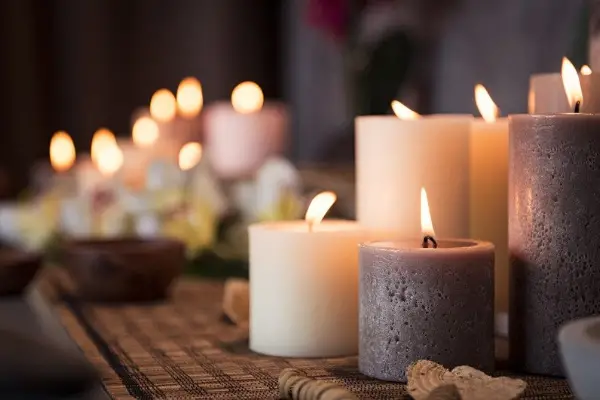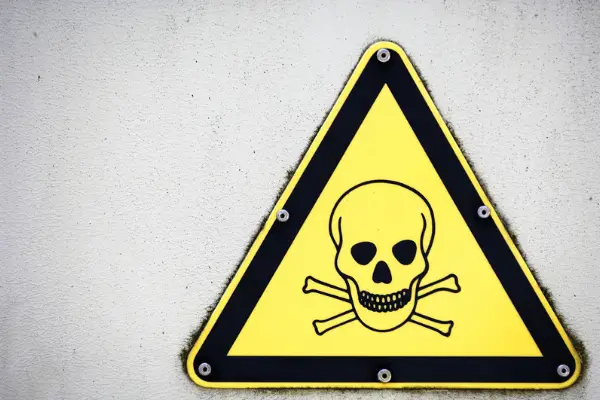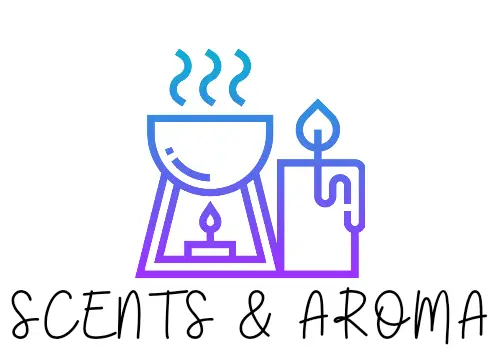Candles have been used as a source of light and to illuminate the world for more than 5,000 years. The candle is an ignitable wick, embedded in wax or another flammable semi-solid, which provides both heat and light and, in some cases, scent.
The earliest use of candles dates back to the Ancient Egyptians who made torches by soaking the pithy core of reeds in melted animal fat. Thus, they produce a slow-burning and reliable source of light.
Ancient Romans also made early candles, but instead of reeds, they used papyrus, while people in ancient China made candles from whale fat and wax from seeds and insects.
Candles are created from a range of flammable substances but are solid at room temperature and melt when in contact with heat from any source. These substances include natural fats, tallow, or wax.

Wax is the most widely used substance to make candles, and although we do not use candles as a primary source of light anymore, we have come to appreciate its other uses.
In this article, we will explore using candles as a source of heat. We will find out if it is feasible enough or if it does more harm than good.
Can candles heat a room?
To start off I am just going to give you a summarised answer of the article, for those that are not interested in the science and math behind it.
So can you use candles to heat up a room? Simply put, using candles to heat a room may seem like a good idea. In reality though you would need so many candles that it would be a health hazard to achieve success. So no, you should not try to heat up a room with candles as that is not their intended purpose.
If you love math and science then the next part of the article is for you. I will tell you the math needed to find out how many candles it would theoretically take to warm a room up.
How much heat does a candle give off?
We know that there are different types of candles. However, a modern candle typically burns at a steady rate of about 0.1 g/min, releasing heat at roughly 80 W.
A candle’s flame is approximately 1,500°F, but in theory, 80W is somewhat equal to a relatively dim light bulb. Candles have an efficiency of around 90%. This means that 90% of the released energy is heat, whereas the rest is light.
How many candles would it take to heat a room?
You need to calculate how much heat one would need to keep a room warm to know how many candles you would need to heat a room.
A 10 x 10 room with 10-foot ceilings will require 1000 watts to heat up the room. We estimate that 10 watts will be needed per square foot. Multiply the square footage of the room by 10. A room with 100 square feet will require 1,000 watts.
However, this would only work in an ideal situation; hence, we need to consider the following parameters.
- The Candle Type
Different types of candles burn at different temperatures and rates. Beeswax candles take the longest time to burn, but they burn slowly. Soy wax candles may burn as long as beeswax candles, but they have a lower melting point; hence, they are easier to deal with.
Paraffin wax candles have the shortest burn time. It is essential to take note of these because when trying to heat a room, you will often need to replace the candles. Those with shorter burn time mean more replacement in the course of 24hours.
- The Room Size
A larger room would require more heat and therefore more candles. It would also take an ample amount of time for the candle to heat it.
The Surrounding temperature: The temperature surrounding a room could also affect the ability of a candle to properly heat the room. A poorly insulated room would end up losing all the heat the candle generates.
- Insulation
A perfectly insulated room ensures that there is no ambient heat loss to the surrounding through the room walls, doors, windows, or floors. This ensures that whatever amount of heat the candle is generating is evenly distributed around the room and that the heat transfer rate is fairly stable. To properly insulate a room, seal all openings.
According to Heater tips, “To heat a room, you need about 20 candles”. If one candle has a heating power of about 80 Watts, then 20 candles would give us a heating power of 1600 Watts, which, theoretically, should be more than enough to heat the 10 x 10 room we talked about earlier.
However, since a candle emits heat energy of about 80 watts, it is crucial to note that it takes about 20 watts to heat 15 cubic feet of space by one degree for one hour. This proves how limited the potential of a few candles is to heat up a room, even if all conditions are met and the candles are replaced every few hours.
To put it simply, if you had 20 or 30 candles to use for heating a small but perfectly insulated room, you would only be able to raise the temperature a few degrees.
Asides from this, the candle size influences and limits the heating time. Small tea candles may burn for 3-4 hours, while standard-sized candles burn for only 7-9 hours.
This means that the candles would have to be replaced continuously. At this rate, you might need about 120 candles to heat a single room for 24 hours.
Does burning candles make the room feel warm?
To reiterate, in heating a room, you have to know what the heat loss ratio is from outside and how the insulation works. You also have to seal up all openings, including vents, windows, and doors. However, after this and you have a perfect seal with zero heat loss, then an oxygen issue presents itself.
Candles are an oxygen-burning fuel source, and completely sealing up a room means that there is a limited time before the fire uses up all the oxygen in the room and suffocates itself. This also presents a problem for the occupants in the room who are trying to keep warm.
The heat generated from an uncovered candle is generally dispersed among a room, absorbed by the walls and furniture, and lost through the doors and windows. This general heat loss plus the disadvantage of complete insulation makes candles an inefficient alternative for effectively heating a room.
Is it safe to heat a room with candles?
Heating a room with candles requires a surplus supply of candles and utmost concentration as anything could go wrong. You have to replace the candles every few hours and relight the ones with a stray gust of wind or a harsh swishing of skirts quenched.
If you are heating a room throughout the day, you would need to care for hundreds of candles simultaneously, and this presents a problem for those who have children, pets, or other flammable things lying around.
- Hazard

For one, having an open flame out, for whatever reason, is a hazard to all occupants of the house.
The risk doubles if you have young children, people living with any form of disability, or pets because they could knock your bunch of burning candles to the ground, and house fires are a very high price to pay for some warmth.
There is always the risk of a few, if not all, candles toppling over, which might result in nearby curtains or flammable items like newspapers and books catching fire.
Also, if you are using tea light candles placed too close to each other- If poorly watched, the thin aluminum that holds the candles could melt and cause paraffin to leak out. This can also cause a huge fire hazard.
- Soot
For those who regularly use candles, especially paraffin wax candles, there is always the subject of soot-covered drapes, curtains, and walls. This is a side effect of using open flames.
The smell of soot can cause respiratory irritation in people with more sensitive respiratory systems.
The accompanying smoky smell could trigger people with asthma or other respiratory problems. Soot-covered carpets and walls are not aesthetically pleasing and may need a lot of care to repair.
- Poisoning
Any heater enclosed in a small room with poor ventilation presents the risk of poisoning, usually with carbon monoxide, termed the “silent killer” because it’s colorless, odorless, tasteless, and non-irritating.
Even though the level of toxicity of some candles, especially paraffin wax, is debatable, it emits toxic gases when burned, which are dangerous to health in the long run.
To ensure safety, we recommend that you keep the room well ventilated- make sure there is a constant flow of air to allow the toxic gases to escape.
To read more about if candles produce carbon monoxide have a look at this guide that I wrote.
To ensure safety and ensure that the room is well ventilated, we recommend that you keep a fire extinguisher nearby and know how to use it.
Be sure to place the burning candles over a safe, non-combustible surface, such as a tile or cement floor. Do not place it over or near paper, magazines, carpet, walls, flammable materials, or any unstable surface.

CAN YOU HEAT A ROOM WITH CANDLES IN A FLOWER POT?
You can use tea candles to heat a small room by placing them underneath a flower pot. For this setup, a terracotta pot is most preferable as a plastic pot would only end up burning.
First, you light up the candles using a stable metal dish or non-flammable, sturdy material as the base. The terracotta flower pot is inverted ie., placed with its widest end facing the ground.
The hole on the bottom of the flower pot is left open to let hot air rise and escape through it. An object should be placed between the base and flower pot opening- this provides oxygen for the fire to burn and sucks cold air from below as the hot air rises.
The candles generate heat as they burn, which escapes through the flower pot to heat the air. This air circulates to warm up the space in the room.
The air also heats the flower pot, which radiates heat. Light from the candles is also trapped and converted to more heat by heating the ceramic pot.
Essentially, the candle transfers its heat through convection while the flower pot radiates the generated heat.
This setup might not do much to heat really large spaces since the same amount of heat is being emitted by the candles whether there’s a pot above them or not.
While the candles still emit the same amount of heat energy, the terracotta pot helps to hold and radiate the heat, concentrating it in a small area.
Although you cannot use it to warm up a room, you can use it in cases of a sudden blackout or emergency- when you sit near the clay pot, you will feel the heat that isn’t rising to the ceiling. Hence, it is readily available to you in that time of need.
FINAL THOUGHTS
In an ideal situation, where you create a perfect seal in the room with absolutely no heat loss, the candles should be able to warm up the room, albeit slowly. This; however, presents an oxygen problem as an unventilated fire is a bad idea.
So, while candles might warm up a room, they should be reserved as an absolute last resort as they are inefficient, dangerous, expensive in the long run, and accumulate soot.
There are much safer alternatives if you’re going for something independent of electricity like space heaters and thermal curtains.
- Can You Put Perfume In A Humidifier? (Read First) - September 17, 2022
- Can You Put Essential Oil In A Steam Mop? (Safety Advice) - September 17, 2022
- How To Make Lavender Oil At Home ( Candles And Diffusers) - September 9, 2022
